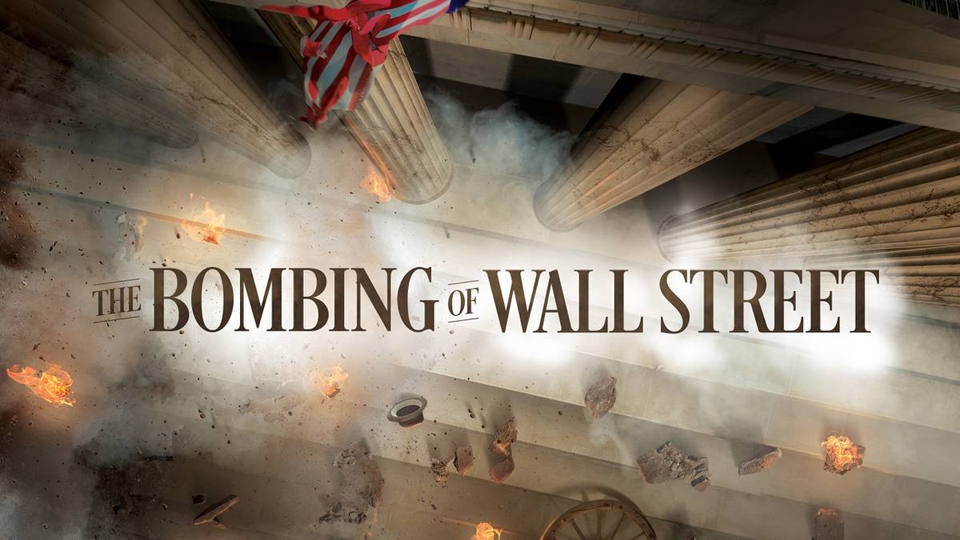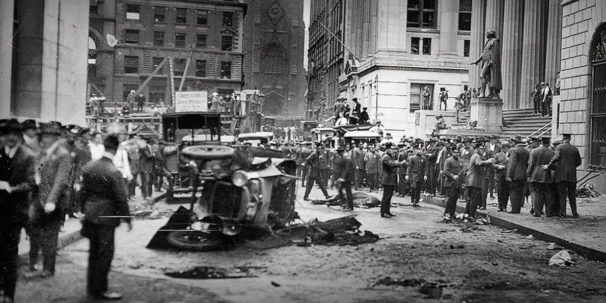
PBS’ award-winning history series American Experience offers writer director Susan Bellows’ The Bombing of Wall Street this February. Bellows’ film is based on Beverly Gage’s book The Day Wall Street Exploded: A Story of America in its First Age of Terror.
Bellows certainly depicts an all too familiar picture of terrorism and mayhem. In April and May of 1919, a wave of bombs was mailed to prominent bankers and government officials. On September 16, 1920, a horse-drawn wagon packed with dynamite exploded on Wall Street at Morgan Bank, the country’s premier financial institution. Thirty-eight were killed and scores more injured. Most were workers and passersby.
Bellows uses the explosion to explore the forces that led to the bombing, its outcome, and the meaning it came to have for American society. Her work is especially timely as these issues dominate today’s political agenda.
Millions of immigrants flocked to the United States in the decades leading up the bombing. Industrial development provided employment. But the nature of that development magnified economic disparity. Work was long, hard, and dangerous. Wages were low. Workers tried to organize for higher wages and better working conditions. Employers and owners fought unions, trying to maximize profits at workers’ expense.
These immigrants were significantly different from their white Anglo-Saxon Protestant predecessors. They were largely olive-skinned Southern Europeans and Slavic Eastern Europeans, often carrying with them ideologies that advanced human rights. The Russian Revolution shone a bright light on what might be accomplished to improve working-class lives. The U.S. Constitution and American ethos held up ideals which the immigrants sought to realize.
Standing in the way was the economic system which promised much to many, but rewarded far fewer. Those whom it rewarded were threatened by these same immigrants who created their profits.

Those in power reacted to the bombings, labor unrest, and immigrant fears by building police and espionage forces. Attorney General A. Mitchell Palmer ordered large-scale raids in November 1919 and January 1920 that resulted in the illegal detention and deportation of hundreds of immigrants without trial or conviction. Their crimes were either being in the wrong place at the wrong time or subscribing to heterodox political views.
To compound the government’s illegal response to this Red Scare, Palmer created the Justice Department’s “Radical Division of the Bureau of Investigation.” To head it up, Palmer appointed an ambitious young lawyer who was determined not to let the law and Constitution impede his crusade to roust radicals—and that would be one J. Edgar Hoover.
The rise of Hoover, immigrant phobia, and the clash of capital and labor presaged our current conflicts. Bellows does well to use the Wall Street bombing as a primer for the American Experience.
The Bombing of Wall Street can be seen premiering on PBS February 13. Please consult your local station for exact showing times. Online viewing is available beginning February 14 at pbs.org.

MOST POPULAR TODAY


Zionist organizations leading campaign to stop ceasefire resolutions in D.C. area

High Court essentially bans demonstrations, freedom of assembly in Deep South

Afghanistan’s socialist years: The promising future killed off by U.S. imperialism

Communist Karol Cariola elected president of Chile’s legislature






Comments